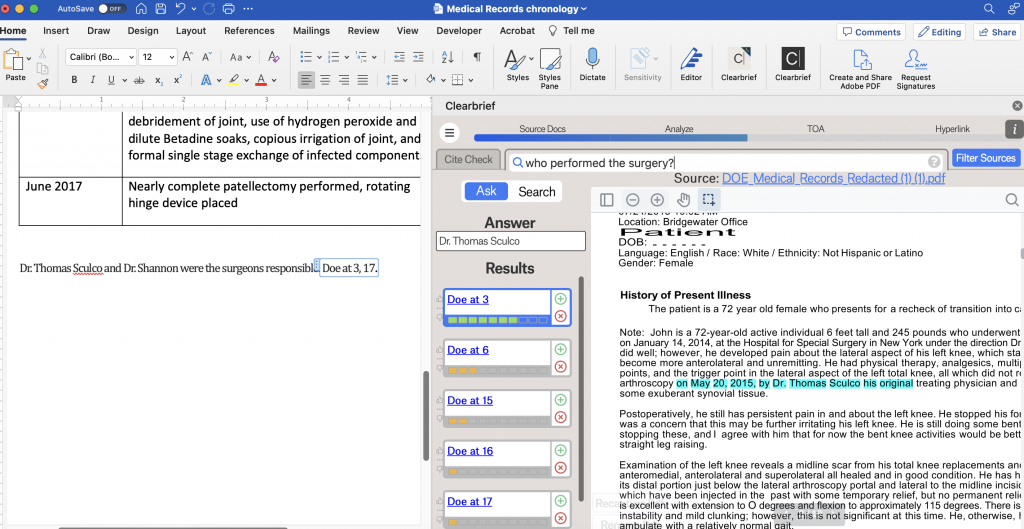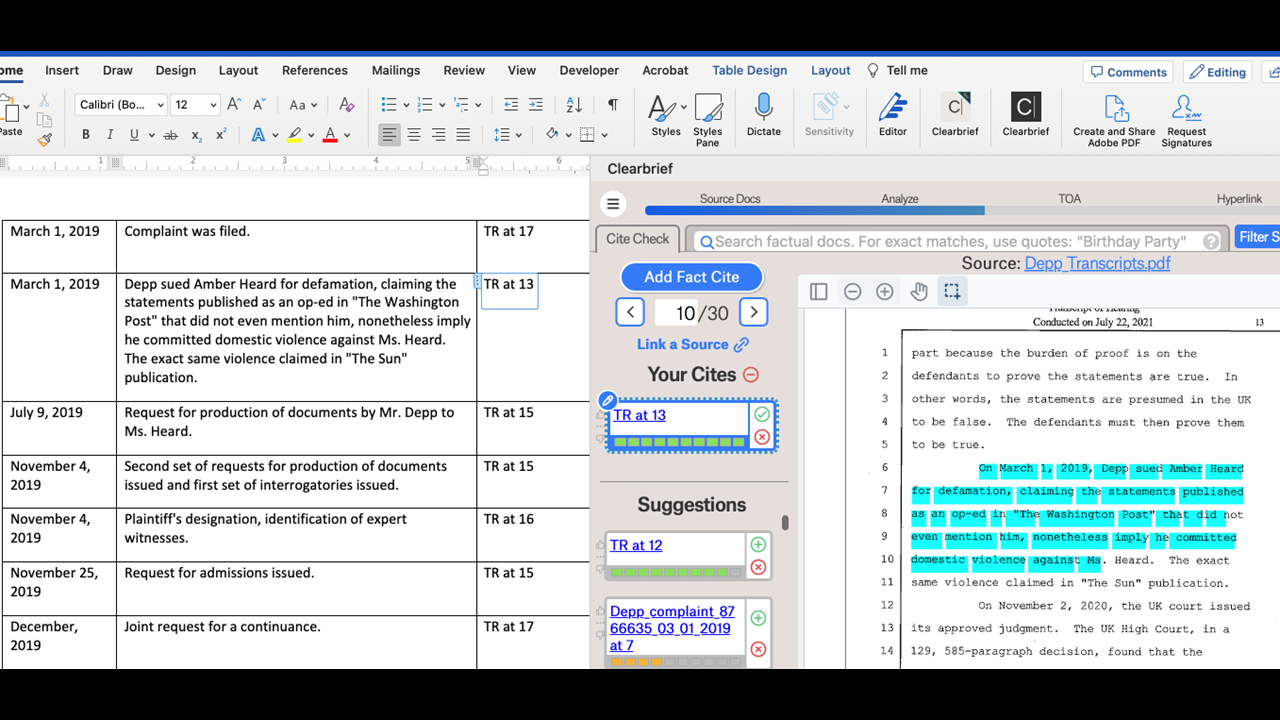The Seattle-based legal tech startup Clearbrief already uses artificial intelligence to strengthen your legal writing by finding the best evidence in the record to support your arguments (or debunk your opponent’s). But today the company is introducing two AI-powered features that further enhance the product by enabling legal professionals to instantly create hyperlinked timelines and ask questions of their documents.
If you are not familiar with Clearbrief, it is an innovative product designed to strengthen brief writing or other legal writing in Microsoft Word by instantly finding the best evidence or law to support your argument. It examines the discovery, exhibits, pleadings and other documents in a case and automatically finds and displays citations to the source documents that provide the factual support, as well as case law, statutes and regulations.
Hyperlinked Timeline
One of the features being introduced today, Hyperlinked Timeline, builds on Clearbrief’s ability to create hyperlinks to source documents in the case record. Using the power of generative AI, it extends that ability to a different but related purpose — the creation of case timelines. Now, with the click of a button, a user can generate a case chronology directly in Word, complete with hyperlinks to the source documents that support the dates and events shown in the timeline.
Read more about Clearbrief in the LawNext Legal Technology Directory.
Clearbrief’s founder and CEO Jacqueline Schafer demonstrated the feature for me on Friday, and it impressed me for its ability to extract key dates and events even when they were not explicitly connected in the underlying documents.
A litigator before founding Clearbrief, Schafer said that assembling a timeline is one of the first things a lawyer has to do when starting a new case. Typically, that involves a tedious and time-consuming process of sifting through documents and emails and looking for pertinent dates. Often, the connections between dates and events are not explicit within the documents, but rather need to be implied, such as from something someone said in a transcript.
Clearbrief’s Hyperlinked Timeline does that work for you, creating a chronology in just seconds.
As the video above shows, the user starts by uploading a set of source documents, which may include discovery documents, transcripts, emails, pleadings, or whatever else. To make it easier to pull in documents, Clearbrief integrates with document management and e-discovery platforms such as NetDocuments, iManage and Relativity. From that document set, the user can select which documents to use to generate the timeline.
Once the user clicks done, it generates a timeline, shown directly in Word in a table format, that provides the date of the event, a description of what happened, and the citation to the record. The citation is hyperlinked so that the user can see the source document in an adjacent window and verify the entry.
Within the source document, the specific text that supports the timeline entry is highlighted in blue so that the user can see it easily. As the user views the timeline and the supporting documents, the user can edit the timeline to make any needed changes to the dates or descriptions.
In one example that Schafer showed me, the timeline included the entry, “December 2015: First controlled buy at Yakima stash house,” with a link to the record.
That linked to a document that said:
“You heard testimony about the controlled buys involving this methamphetamine from that East Selah Road stash house in December 2015 and in January 2016. The first controlled buy took place at that stash house.”
Thus, the AI was able to extract that the first controlled buy took place in December 2015 and add it to the timeline.
Once the timeline is created, the user can share it with anyone else, complete with hyperlinks to the source documents, even if they are not themselves Clearbrief users.
“I could just send this to a partner and they don’t have to know how to do anything in Clearbrief. They can just click and they can see and verify every single page and every single document.”
“Clearbrief’s new Hyperlinked Timeline provides a huge advantage to lawyers working on tight deadlines, as you can now click a button, and instantly have a draft chart right in your Word document with hyperlinks to the sources,” she said.
‘Ask Your Docs’
The second feature Clearbrief is introducing today, Ask Your Docs, does what its name suggests, allowing legal professionals to ask specific questions of their document sets. The AI provides suggested answers to the question, as well as hyperlinks to the source documents on which it is basing those answers, so that the user can verify the information.

With Clearbrief’s Ask My Docs feature, you can ask a question and see where it is answered in a document set.
While Clearbrief already provides users with multiple ways to search documents, this enables them to quickly find answers to specific questions or to find “that one thing they just can’t remember,” Schafer said.
During our demonstration, and as the video below also shows, Schafer offered the example of asking a set of documents, “Who performed the surgery?” It immediately provided the answer of a doctor’s name, with a link to a document in the record. That document was a portion of a medical record indicating that the subject had undergone “left knee arthroscopy” performed by the named doctor. (There was no express mention of “surgery.”)
But it did not stop with that first answer. It also showed other possible answers based on other references in the record, allowing the user to quickly browse through the relevant documents and decide on the correct answer or best answer.
“My philosophy is it is not realistic at this point in time to train lawyers to become prompt engineers and expect them to set up their own ecosystems,” Schafer said. “To make this technology truly transformative for everyone, from the smallest firm to the largest firm, we need to build it in a way that’s very aligned with the workflows that they already have, where they just want to do it faster, but they can’t compromise on accuracy.”
‘Trust But Verify’
Clearbrief’s new Hyperlinked Timeline feature is being powered by Microsoft’s Azure OpenAI, while the Ask Your Docs feature is powered by the company’s existing proprietary technology.
By using Microsoft’s Azure OpenAI, users can be assured that none of their information or activity is being shared outside the platform or being used to train third-party AI models, Schafer said.
She also said that Clearbrief is certified as SOC2, Type 2, compliant, so that users can be confident that their documents are secure.
Even so, a concern with using generative AI in legal applications is that the technology has the capability of “hallucinating” — of simply making up answers that have no grounding in facts. That is why, said Schafer, it is important for users of the technology to “trust but verify.”
With both of these new features, Clearbrief’s approach eliminates any concerns about hallucinations by providing hyperlinks directly to the documents that form the basis of the information being provided. Both the immediate user and others on the user’s team are able to corroborate the information for themselves by viewing the source documents.
Still, understanding that some legal professionals remain uncomfortable with using generative AI, Schafer said that she is making the Hyperlinked Timeline feature available only on an opt-in basis, meaning that the feature will be available to a user only if the user chooses to activate it.
Also, as of this writing, she had not decided whether to charge users an additional fee for the timeline feature. The Ask Your Docs feature will be available to all Clearbrief users.
Launched in 2021
Clearbrief launched in March 2021 with backing from a notable roster of investors, including Mark Britton, the founder and former CEO of Avvo; Bryan Garner, legal writing expert and editor of Black’s Law Dictionary; and Bill Neukom, longtime Microsoft general counsel, and subsequently raised a $3.5 million seed round.
Others who subsequently invested include including Reign Ventures; Court Lorenzini, DocuSign’s founding CEO; Jack Newton, Clio cofounder and CEO; and Amy Weaver, president, CFO and former chief legal officer at Salesforce.
Since its founding it has earned a number of accolades, including the 2023 Legalweek Litigation Technology Product of the Year, the 2022 Clio Launch//Code contest for best new app, Legalweek 2022 New Law Company of the Year, American Legal Technology Awards 2021 Legal Tech Startup of the Year, and 2021 Washington State Bar Association APEX Legal Innovation Award.
It was also a winner of the 2022 Startup Alley competition that I organize as part of ABA Techshow.
 Robert Ambrogi Blog
Robert Ambrogi Blog